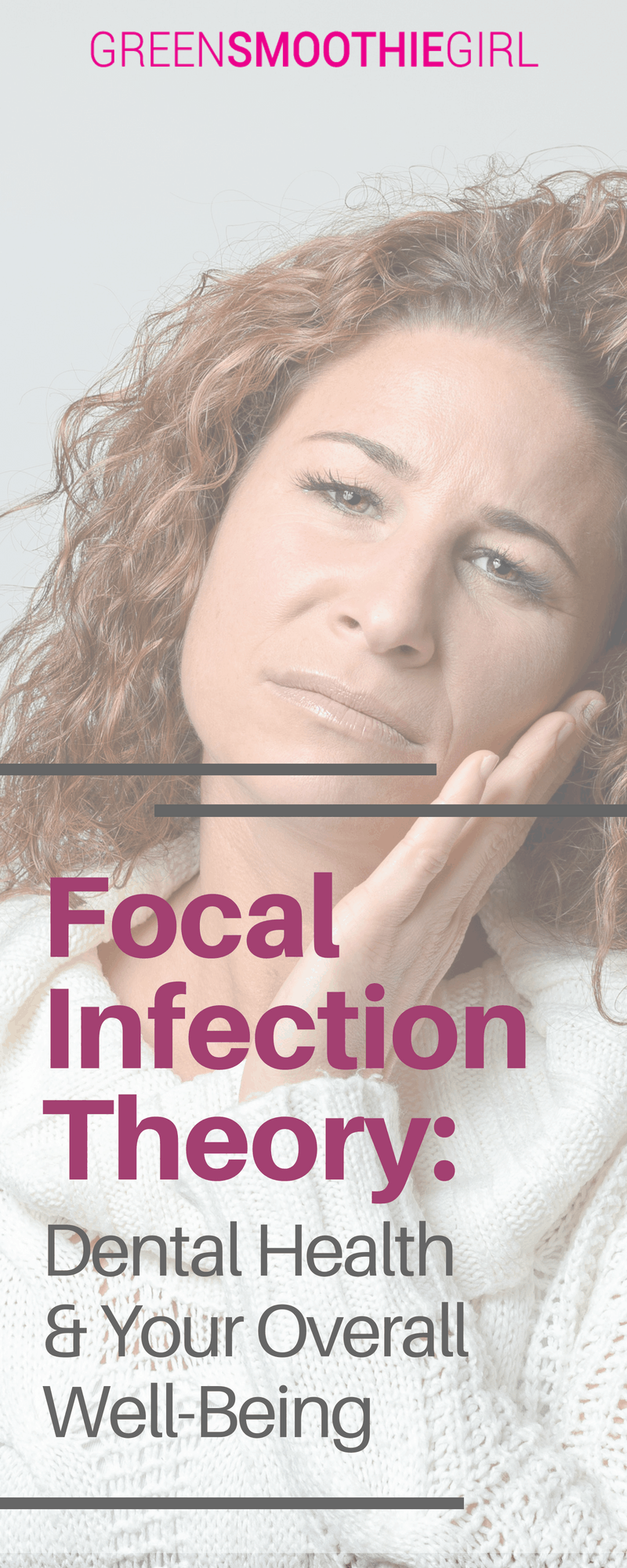Focal Infection Theory: Dental Health & Your Overall Well-Being

The idea that every part of our body is holistically connected to each other is fairly well-accepted. You know that meditation can increase your physical energy, and stress can manifest itself as back pain or stomach issues. There’s even evidence that your mind can heal your body from disease – and that some conditions have a strong possibility of causing other ailments.
For centuries, people have explored the connections between co-occurring conditions – two diseases that are often experienced by patients at the same time or back-to-back. Hippocrates is said to have “cured” his arthritis by removing a tooth. The autointoxication theory1 suggested that toxins from the gastrointestinal tract could leak into the body, causing anything from fatigue to insomnia.
In the early 1900s, Henry Cotton believed mental illness was caused by bacteria and removed organs like stomachs, colons, and more in an attempt to cure patients in asylums1 under the practice of “surgical bacteriology.”

Over-eager physicians started removing teeth and organs in the hopes of curing diseases, but when the removals had no effect – or worse, resulted in the deaths of an excessive number of patients – many of these theories were discontinued and forgotten.
That’s the case with focal infection theory, which was the foundation for theories like autointoxication theory and surgical bacteriology. However, in recent years, the idea has experienced resurgence as modern science has found increasing evidence to support what was once a widely-held popular belief.
What is Focal Infection Theory?
Focal infection theory is simply the idea that an infection in one part of your body can cause infections or inflammation in other places2. It begins with something in your body becoming infected – either from exposure to something toxic in the area or because of harmful bacteria. This original infection is called the focus of infection, and while it can occur anywhere on your body, it’s most commonly found in the mouth, sinuses, or tonsils.
Here’s an example. You’ve had a root canal, and instead of making things better, it’s made everything worse. Your tooth has become infected and is the “focus of infection.” Now, the bacteria or toxins from your infected tooth can travel through your bloodstream or your lymph nodes2, wreaking havoc on other parts of your body. The secondary infection you get wherever those bacteria or toxins land and create trouble is considered to be caused by the initial focal infection.
Is Focal Infection a Real Issue?
Recent research has confirmed that bacteria from the mouth have been found in all sorts of seemingly inexplicable locations around the body3. There’s also strong evidence that when harmful bacteria or toxins move to other sites in your body, they may be connected to a full range of conditions, like:
- brain and skin abscesses
- pancreatitis
- diabetes
- gastritis
- pneumonia
- heart disease
- cancer

While focus infections can occur anywhere, current research predominantly looks at focal infection involving the teeth and gums, especially periodontal disease. Recent results show that there are in fact connections between infections in the gums and a whole range of chronic health conditions, particularly when it comes to cancer.
Studies from 20174 showed that women who had a history of gum disease had higher risks for being diagnosed with the following types of cancer:
- breast
- lung
- esophagus
- gall bladder
- skin
Periodontal disease has also been linked to medical conditions like coronary heart disease5, stroke6, low birth weight7, and rheumatoid arthritis8. When dental and periodontal procedures were completed to remove oral focal infection in asthmatics, patients with asthma saw a notable reduction in symptoms9.
While most focal infection research involves periodontitis, researchers have discovered that focal infections in the tonsils also are associated with other conditions in the body. Patients with psoriasis and hives have been found to have high rates of focal infections10, particularly tonsillitis, suggesting the two may be related. Additionally, tonsillitis triggers and worsens symptoms of Palmoplantar pustulosis11, an inflammatory disorder that appears as lesions on the palms and soles.
How Can I Prevent a Focal Infection?
Since there are so many established connections between focal infections and other types of disease, “better safe than sorry” is a reasonable and practical approach. Most focal infections begin in the sinuses, tonsils, or oral cavity, so preventing bacteria and avoiding toxins in these areas using the following techniques is a great place to start:
- A neti pot saline rinse11 is effective at helping to keep sinuses moisturized and cleared of bacteria.
- Gargling with warm salt water is both soothing to the tonsils and can help rinse the area.
- Oil pulling with coconut oil detoxifies and takes advantage of coconut oil’s natural antibacterial properties.

Cleansing the oral cavity is a little more involved, since there are so many surfaces and crevices in which bacteria can settle. An oral care routine that includes the gums, teeth, and tongue is a smart idea not only for preventing focus infections, but also for maintaining a healthy mouth. Recommended care includes:
- Brushing and flossing regularly.
- Eating a healthy diet with lots of greens, berries, and nuts, and little to no sugar.
- Oil pulling
- Avoiding exposure to toxins like root canals and amalgam fillings that can be harmful to the body.
- Scheduling regular cleanings to remove the tartar that causes gingivitis and periodontitis.
- Visiting a biological dentist (also called a holistic dentist), who may be better equipped to prevent or identify issues related to focal infections.
What Should I Do if I Think I Have a Focal Infection?
If you have receding gums, amalgam (silver) fillings, have ever had a root canal, or have any chronic swelling or lesions in your mouth, visit a holistic dentist for an evaluation. Because these biological dentists have additional holistic training beyond dental school, they understand the link between your oral health and your overall health, and they have invested in special tools and procedures for a more thorough evaluation.
Holistic dentists can address the mouth issues that may be causing you trouble elsewhere in your body, but they will likely also refer you to other health professionals to evaluate the bodily symptoms that could be associated with your particular type of focal infection.
As more discoveries are made about focal infections and how they cause other conditions, there’s hope that patients and their health professionals will be able to take reasonable action to stop more serious diseases from developing. But don’t take your chances–prevent focal infections from ever happening by following hygiene routines, avoiding toxins, and regularly visiting a holistic dentist. Find one in your area with our unique Holistic Dentist Finder.

Robyn Openshaw, MSW, is the bestselling author of The Green Smoothies Diet, 12 Steps to Whole Foods, and 2017’s #1 Amazon Bestseller and USA Today Bestseller, Vibe.

SOURCES
- Wessely S. Surgery for the treatment of psychiatric illness: the need to test untested theories. Journal of the Royal Society of Medicine. 2009;102(10):445-451. doi:10.1258/jrsm.2009.09k038.
- Xiaojing Li,*Kristin M. Kolltveit, Leif Tronstad, and Ingar Olsen Systemic Diseases Caused by Oral Infection. Clin. Microbiol. Rev. October 2000 vol. 13 no. 4 547-558 doi: 10.1128/CMR.13.4.547-558.2000 Retrieved from https://cmr.asm.org/content/13/4/547.full
- Kumar PS. From focal sepsis to periodontal medicine: a century of exploring the role of the oral microbiome in systemic disease. J Physiol, 2017. 595, 465–476.
- Ngozi N. Nwizu et al. Periodontal Disease and Incident Cancer Risk among Postmenopausal Women: Results from the Women’s Health Initiative Observational Cohort. Cancer Epidemiol Biomarkers Prev; 26(8); 1255–65
- Mathews Marc J. et al Oral health and coronary heart disease BMC Oral Health 2016 16:122
- Sfyroeras GS, Roussas N, Saleptsis VG, Argyriou C, Giannoukas AD. Association between periodontal disease and stroke.J Vasc Surg. 2012 Apr;55(4):1178-84.
- Haerian-Ardakani A, Eslami Z, Rashidi-Meibodi F, et al. Relationship between maternal periodontal disease and low birth weight babies. Iranian Journal of Reproductive Medicine. 2013;11(8):625-630.
- Bingham CO, Moni M. Periodontal disease and rheumatoid arthritis: the evidence accumulates for complex pathobiologic interactions. Current opinion in rheumatology. 2013;25(3):345-353. doi:10.1097/BOR.0b013e32835fb8ec.
- Haryono Utomo Management of oral focal infection in patients with asthmatic symptoms Dental Journal, 2006: v39.i3.p120-125
- Brzewski PŁ, Spałkowska M, Podbielska M, et al. The role of focal infections in the pathogenesis of psoriasis and chronic urticaria. Advances in Dermatology and Allergology/Postȩpy Dermatologii I Alergologii. 2013;30(2):77-84. doi:10.5114/pdia.2013.34155.
- Yamamoto T. Triggering role of focal infection in the induction of extra-palmoplantar lesions and pustulotic arthro-osteitis associated with palmoplantar pustulosis. Adv Otorhinolaryngol. 2011;72:89-92.
This article may contain affiliate links, which allows you to support our mission (as well as demonstrate market demand for safer products) without costing you extra.
Posted in: Dental Health
















No comments found, but you can be our first!